| |
|
| |
| |
|
Welcome
Welcome to the July issue of the USAPEEC ASEAN Regional Office’s newsletter.
This newsletter seeks to provide readers with useful product and major market information for institutional and consumer users of U.S. poultry. Readers will find in every issue a variety of general market information, program activities as well as useful product information.
This issue, we share several activities that took place in Southeast Asia.
Contents:
- USAPEEC President meets Vietnamese Prime Minister in New York City
- Poultry cooking workshop generates awareness in U.S. poultry products
- Member companies flocked to attend the USAPEEC Annual Meeting 2017 in Cancun
- News Bites
- The evolution of sushi
- Bone broth: How to make it and why it is good?
- Singapore’s glamorized local favorites
- 3 popular duck dishes in Asia
|
|
|
| |
|
|
|
| |
|
Additional Market Information Available
We have updated our website to include more information on market reports and export documentation guidelines.
You can visit our ASEAN website at: www.usapeecasean.com |
|
|
| |
|
|
|
 |
|
USAPEEC President meets Vietnamese Prime Minister in New York City
During a recent visit to the United States, Vietnamese Prime Minister Nguyen Xuan Phuc met USAPEEC President Jim Sumner at a breakfast roundtable in New York City on May 31, 2017.
Forty business leaders including U.S Ambassador to Vietnam Ted Osius and Senator Chris Coons participated in the roundtable discussions. Several key trade issues involving U.S. poultry products and offal trade with Vietnam were discussed. Jim Sumner shared with the visiting Vietnamese delegation USAPEEC’s long involvement with the Vietnamese Poultry Association (VIPA) dating back to 2004, including the assistance to the latter in its efforts in the avian influenza education campaign.
Jim Sumner also made reference to the assistance provided by the World Poultry Foundation in support of the Vietnamese poultry industry hatchery program. Mr. Sumner noted that the Vietnamese officials seemed genuinely pleased by USAPEEC’s assistance efforts. |
|
Vietnamese Prime Minister Nguyen Xuan Phuc meets USAPEEC President Jim Sumner |
| |
|
|
|
|
|
Poultry cooking workshop generates awareness in U.S. poultry products
A U.S. poultry cooking workshop was conducted on June 20 in a local community center for a group of home-makers. The session generated greater interest and awareness of U.S. poultry products.
The workshop was presented by Ms. Katherine Chew, a local instructor who showcased two local recipes; baked char siew U.S. chicken leg and braised noodles with shredded U.S. chicken. The workshop was intended to create awareness of U.S. poultry and impart cooking skills in the preparation of nutritious dishes using U.S. poultry ingredients. Margaret Say, USAPEEC Regional Director, shared about the benefits of U.S. poultry with an emphasis on food safety and nutrition to the participants.
From the brief survey of responses collected during the event, an overwhelming majority (41 out of 44 respondents) indicated that they were more aware of the use of U.S. poultry after the workshop as compared to the lower level of awareness (an average of half of the respondents) before attending the workshop. A similar majority (40 out of 43 respondents) were more aware of the nutritional qualities and food safety standards of U.S. poultry after the workshop. Most of the respondents (35 out of 44) indicated that they were likely to use U.S. poultry for their menu planning in future. |
|
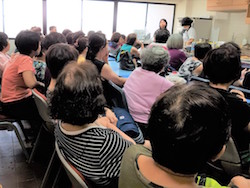 |
Participants at cooking demo at Clementi CC |
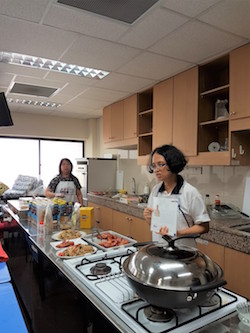 |
Presenter Katherine Chew displays cooking skills at the poultry workshop at Clementi CC |
| |
|
|
|
 |
|
Member companies flocked to attend the USAPEEC Annual Meeting 2017 in Cancun The USAPEEC Annual Meeting was held at Cancun, Mexico during June 12 to 15, 2017. It attracted over 220 participants consisting of representatives of USAPEEC member companies, invited guests, USDA representatives and USAPEEC country directors and head office staff.
The four-day conference featured a diverse slate of VIP speakers including Will Sawyer from Rabobank, Dr. Adis Dijab of APHIS, Keith Sunderlal, SGS Group, Dr. Paul Aho of Poultry Perspective and a key note speaker, Jason Hafemeister, Acting Undersecretary, USDA. The agenda covered a number of thought-provoking subjects, which included International Marketing Forums and Panel discussions on the New Zealand Trade Mission and the Strategic Marketing Conference, which took place in Seoul earlier in 2017. |
|
A section of the delegates attending the USAPEEC Annual Meeting in Cancun |
| |
| |
|
|
|
|
|
News Bites
Singapore
Reduction of geographical restriction for U.S. poultry originating from HPAI affected counties
Singapore has recently agreed to scope down the Highly Pathogenic Avian Influenza (HPAI) restrictions from county level to the control area (which is 10 kilometers beyond the perimeters of the infected premises). The reduction in the geographical area of restriction for the export of poultry products is most helpful for the U.S. poultry export industry. For further clarification of the geographical scope of the restricted areas currently impacted by the HPAI outbreaks, reference may be made to FSIS export library for the Singapore market which clearly outlines the limits of restrictions for the affected areas: https://www.fsis.usda.gov/wps/portal/fsis/
topics/international-affairs/exporting-products/export-library-requirements-by-country/Singapore
Philippines
Extension of reduced tariff rate of five per cent on MDM imports
Philippines announced through its Executive Order No.23, the extension of the reduced tariff rates of five per cent on imports of mechanically deboned or separated meat from July 1, 2017 to December 31, 2020. Thereafter, on Jan 1, 2021, the tariff rate will revert to 40 per cent. The same Executive Order also announced the extension of the reduced tariff rate of 20 per cent on imports of frozen whole turkey till December 31, 2020. For further details on the Executive Order please refer to the USDA Manila which may be accessed through the web link: Executive Order Extends Tariff Concessions_Manila_Philippines_5-25-2017 |
|
|
| |
|
| |
|
|
|
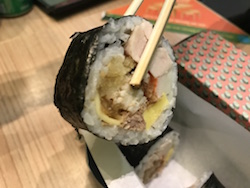 |
|
The evolution of sushi
Sushi is a Japanese dish that consists of vinegared rice, combined with vegetables, seaweed, and raw fish1. The concept of sushi originates from a method of preserving excess fish2. Poultry ingredients such as chicken are not usually incorporated in traditional sushi. However, sushi has evolved over the centuries and plenty of unique dishes have been created3.
Sushi started in third century B.C. in Southern China4. The locals used salt and rice to preserve the raw fish for a year. They would remove the rice and consume the preserved fish once ready. This practice spread to Japan and became the first generation of sushi4. Over time, the rice used in the preservation process was not discarded. Instead, it was consumed together with the preserved fish. Vinegar was added to flavor the rice and shorten the sushi-making process5. Due to globalization, sushi is widely available in numerous flavors and unique combinations6. Sushi can be found in the United States, where the famous California and Philadelphia sushi rolls were invented7.
In Singapore, Lepark restaurant uses chicken rice, poached chicken, garlic chili, and seaweed to make poached chicken sushi8. Casual Japanese eatery Maki-San allows customers to customize their sushi using different types of poultry, such as smoked duck and chicken jerky. They offer other unconventional ingredients, which includes Japanese curry, raisins, and mango9.
In the United States, Russian sushi is tailored to the local’s taste by using ingredients such as cream cheese, mozzarella cheese, mayonnaise, and chicken10. Cowfish, an American restaurant selling unique sushi and burgers, created a Thanksgiving sushi roll. It incorporates turkey, green beans, shoestring sweet potatoes, and cranberry sauce known as gobble gobble-ooshi11.
Traditionally or unconventionally prepared, sushi proves to be a versatile dish that allows consumers to have it served with preserved fish or cooked poultry. It is now widely available anywhere in the world from hawker centers to high-end Japanese restaurants to cater to the masses.
References
1 Next Shark. (2016). 5 Reasons Why Real Sushi Lovers Should Never Order Rolls. [online] Available at: http://nextshark.com/sushi-lover-order-rolls/
2 Business Insider. (2015). An illustrated guide to the complete history of sushi. [online] Available at: http://www.businessinsider.com/the-complete-history-of-sushi-2015-2?IR=T&r=US&IR=T
3 Business Insider. (2015). An illustrated guide to the complete history of sushi. [online] Available at: http://www.businessinsider.com/the-complete-history-of-sushi-2015-2?IR=T&r=US&IR=T
4 Business Insider. (2015). An illustrated guide to the complete history of sushi. [online] Available at: http://www.businessinsider.com/the-complete-history-of-sushi-2015-2?IR=T&r=US&IR=T
5 Business Insider. (2015). An illustrated guide to the complete history of sushi. [online] Available at: http://www.businessinsider.com/the-complete-history-of-sushi-2015-2?IR=T&r=US&IR=T
6 Business Insider. (2015). An illustrated guide to the complete history of sushi. [online] Available at: http://www.businessinsider.com/the-complete-history-of-sushi-2015-2?IR=T&r=US&IR=T
7 Sheknows. (2015). 10 Irresistible sushi rolls you'll only find in America. [online] Available at: http://www.sheknows.com/food-and-recipes/articles/1079110/unique-american-sushi-rolls
8 DanielFoodDiary. (2015). Lepark – Mod Sin Tapas Bar At People’s Park Complex Rooftop. [online] Available at: http://danielfooddiary.com/2015/08/20/lepark/
9 The Ordinary Patrons. (2016). Design your own sushi and salad at Maki-San. [online] Available at: https://ordinarypatrons.com/2016/07/11/design-sushi-salad-maki-san/
10 Reader’s Digest. (2016). Around the world in 8 sushi dishes. [online] Available at: http://www.readersdigest.co.uk/food-drink/food-lists/around-world-8-sushi-dishes
11 Raleigh Agenda. (2016). Cowfish Is Selling a Thanksgiving-Style Sushi Roll, the Gobble Gobble-Ooshi. We Tried It. [online] Available at: https://www.raleighagenda.com/7104/cowfish-selling-thanksgiving-style-sushi-roll-gobble-gobble-ooshi-tried/
|
|
Chicken sushi from Maki-San in Singapore |
| |
|
|
|
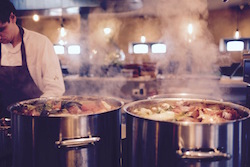 |
|
Bone broth: How to make it and why it is good?
Bone broth is a dish that has been consumed for many decades and recently gained more attention through social media when Chef Marco Canora opened Brodo, a kiosk specializing in broths, in New York1,2.
Bone broth is simple to create. It is a Paleo-friendly dish that is loaded with numerous nutritional benefits.2 The Paleo diet excludes the consumption of dairy, grains, processed food and sugar, legumes, starches, and alcohol to improve health3. Those who adopt a Paleo diet can consume bone broth as their staple food4.
Bone broth includes essential nutrients such as calcium, phosphorus, and magnesium, which are the main components in the skeleton. These nutrients play an important role in many metabolic functions and biochemical reactions5,6. Bone broth is also rich in glycine and proline, which are two important amino acids that are not found in most meat. They are vital to maintain a healthy gut, boost digestion, aid in muscle repair and growth, and achieve a strong immune system. The gelatin in collagen benefits those with inflammatory or autoimmune disorders, reduces joint pain, prevents bone loss and promotes healthy skin, hair, and nails development6.
Bone broth can be prepared by slow boiling animal bones such as beef, veal, venison, pork, chicken, duck, turkey or fish6. Bone broth is produced by boiling the bones of poultry, meat, and fish for long hours. Ingredients such as onions, garlic, carrots and celery are added into the broth to enhance its flavor profile. Marrow bones provide immune-boosting fats that support fertility, growth and development in children. Poultry carcasses are often used as the base for broths. In fish bone broth, fish heads are the most nutritious, with plenty of bioavailable iodine and other nutrients essential to improve thyroid health7.
The quality of the animal that the bones are obtained from impacts the nutritional value of the broth. The bones should come from healthy and non-genetically modified animals for greater health benefits. Animals from whose bones are collected to create bone broth should be fed a natural diet of pure grass. Majority of grass-fed cattle are fattened with grain before slaughter. This removes omega-3 and other essential nutrients and lowers the quality of the bone broth. Free-range and pastured poultry are ideal. Additionally, the bones from younger animals have more gelatins while older animals accumulate more minerals within their lifespans. Choosing the bones from healthy animals would result to achieving a bone broth dish that is full of quality nutrition for consumption7.
References:
1 The New York Times (2015). Bones, Broth, Bliss [Online] Available at:https://www.nytimes.com/2015/01/07/dining/bone-broth-evolves-from-prehistoric-food-to-paleo-drink.html?_r=3
2 Grub Street (2015). How the Bone Broth Debate Boiled Over So Suddenly [Online] Available at:http://www.grubstreet.com/2015/05/bone-broth-debate-boils-over.html
3 Robb Wolf (2016). What Is The Paleo Diet? [Online] Available at: http://robbwolf.com/what-is-the-paleo-diet/
4 The Paleo Diet (2014). BONE BROTH: THE NUTRIENT-RICH SUPERFOOD [Online] Available at: http://thepaleodiet.com/bone-broth-nutrient-rich-superfood/
5 HealthyChildren.org (2015). Minerals: Calcium, Phosphorus, and Magnesium [Online] Available at: https://www.healthychildren.org/English/healthy-living/nutrition/Pages/Minerals-Calcium-Phosphorus-and-Magnesium.aspx
6 Whole9 (2017). The Whole9 Bone Broth FAQ [Online] Available at: http://whole9life.com/2013/12/whole9-bone-broth-faq/
7 Stirring Change (2016). Bone Broth: Your guide to the best bones [Online] Available at: http://stirringchange.com/2016/08/29/bone-broth-guide-best-bones/
|
|
Preparing a typical bone broth dish
|
| |
|
|
|
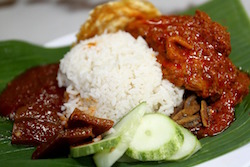 |
|
Singapore’s glamorized local favorites
Singapore is home to a melting pot of cultures. One can expect Chinese, Malaysian, Indonesian, Indian, European, Korean, Mexican, Greek, Peranakan, and Japanese cuisines available at Singapore1. These vast varieties form the widely diverse culinary scene in this country, making Singapore one of Asia’s biggest culinary capitals. The highlight of a Singaporean cuisine is its local street food, which is inexpensive and can be found at any hawker centers2 located throughout the island.
Hawker centers are open-air food complexes that offer a wide variety of local Singaporean foods. These centers are a must-visit to taste authentic Singaporean dishes3. Quality local favorites are sold at affordable prices from S$2.50 to S$6.00 (US$1.80 to US$4.30), including chicken rice, fried kway teow, Hokkien mee, bak kut teh and satay4.
Restaurateurs elevate these local dishes to fine-dining levels for their diners5,6. These humble local dishes are reinvented through new cooking techniques, fusion of flavors and innovative plating, while retaining the local flavors that diners would find familiar. This is known as modern Singaporean cuisine (Mod-Sin), a term coined by local chef Willin Low, who runs Wild Rocket6.
Hainanese chicken rice
One of Singapore’s iconic national dishes, Hainanese chicken rice is a dish adapted from early Chinese immigrants from the Hainan Island. Blanched, roasted or soya sauce-braised chicken comes with fragrant rice which is cooked in chicken stock, ginger, and pandan leaves. It is served with a spicy chili and ginger paste7.
Chatterbox, a high-end restaurant located at the 5-star hotel at Mandarin Orchard, offers a posh ambience for traditional local fares. It has been serving its legendary Mandarin chicken rice dish since 1971. At a whopping S$32 (US$23), it comes with a plate of chicken, a bowl of rice, a bowl of soup and three condiments of chili sauce, ginger paste and dark soy sauce. Its premium price is justified by its sophisticated setting in a prominent hotel, outstanding service and generous serving8.
Nasi lemak
Nasi lemak gets its name from the savory, creamy and aromatic rice that is infused with coconut milk and pandan leaves. It is usually served with deep-fried fish or chicken wings, otah (grilled fish paste), fried ikan bilis (anchovies), along with roasted peanuts, fried eggs, cucumber slices, and sambal (spicy chilli paste). While this is the standard serving by the Malays in Singapore, the Chinese came up with their renditions. Theirs would include other items such as deep fried drumsticks, curried vegetables, and luncheon meat9.
Route 12 is a roadside coffee shop concept along Sam Leong Road. This concept is inspired by its owner Faz’s bike trips around Malaysia and Thailand. Its nasi lemak sotong kingis a huge serving of the nasi lemak dish, served with additional chicken wings and fish, along with a giant deep fried squid. This dish is recommended to share among three to four diners10. Priced at S$18 (US$13), it is significantly more expensive than the traditional version10.
References:
1 City Nomads (2014). SINGAPORE’S CUISINE: THE PAST, PRESENT AND FUTURE OF SINGAPOREAN FOOD [Online] Available at:https://www.citynomads.com/singapores-cuisine-the-past-present-and-future/
2 YourSingapore (2016). Sniffing out local food in Singapore [Online] Available at:http://www.yoursingapore.com/editorials/the-street-food-of-singapore.html
3 TheSmartLocal (2015). 9 Best Hawker Centres in Singapore And Their Star Dishes Every Human Must Try [Online] Available at: http://thesmartlocal.com/read/best-hawker-centres
4 TheBestSingapore (2016). The 5 Best Hawker Centres in Singapore [Online] Available at: http://www.thebestsingapore.com/eat-and-drink/the-best-5-hawker-centres-in-singapore/
5 Weekender Singapore (2017). Great local food or too atas? [Online] Available at: https://weekender.com.sg/w/dining/local/great-local-food-or-too-atas/
6 YourSingapore (2016). Modern twist to local dining [Online] Available at: http://www.yoursingapore.com/editorials/modern-twist-to-local-dining.html
7 YourSingapore (2017). Chicken Rice [Online] Available at: http://www.yoursingapore.com/dining-drinks-singapore/local-dishes/hainanese-chicken-rice.html
8 The Best Singapore (2016). Chatterbox [Online] Available at: http://www.thebestsingapore.com/best-place/chatterbox/
9 YourSingapore (2017). Nasi Lemak [Online] Available at: http://www.yoursingapore.com/dining-drinks-singapore/local-dishes/nasi-lemak.html
10 SethLui.com (2017). ROUTE 12: Biker Coffeeshop Serving The Mother Of All Nasi Lemaks in Singapore [Online] Available at: http://sethlui.com/route-12-nasi-lemak-singapore/ |
|
Upscale Nasi Lemak dish |
| |
|
|
|
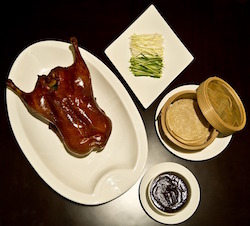 |
|
3 popular duck dishes in Asia Different countries across Asia have their own unique style of incorporating duck into their recipes as the main star of the dish.
1. Peking duck, Beijing
Approximately 600 years ago, the Peking duck was consumed during the Ming Dynasty in Beijing1. Prepared by palace chefs, it was one of the recipes that were leaked to the public as “foods fit for the Emperor”. Served as an appetizer, this dish rose to fame when court chefs started their own businesses after the fall of the Ching Dynasty in 1911.
To begin preparation, air is pumped into the ducks through their neck cavities to separate the skin from fats2. The ducks are blanched and glazed with maltose syrup before drying. They are cooked by roasting in the oven until the skin turns shiny brown and crispy, leaving the meat tender and juicy inside. The Peking duck is considered as one of China’s national dishes3. It is served by carving the duck into lean pieces and paired with thin pancakes, sliced cucumbers and sweet bean sauce.
2. Braised duck rice, Singapore
The braised duck rice dish originates from Singapore. Commonly found at hawker centers, food courts and restaurants, a plate of duck rice consists of braised duck with yam or plain rice. To prepare this dish, the duck is marinated with salt for hours to get rid of its odor. Before cooking, the duck is immersed in a pot full of dark soy sauce and water. The meat is braised for approximately two hours under low heat, allowing the meat to absorb the sauce4.
The duck is deboned and sliced thinly before serving. Similar to the chicken rice dish, the meat is also served with other ingredients such as hard-boiled eggs and cucumber slices. Gravy is also drizzled all over the duck to enhance the flavor of the dish.
3. Nanjing salted duck, Nanjing
Having gained popularity since the Qing Dynasty from 1644 to 1911, the Nanjing salted duck is a crowd’s favorite5. Famous for its fragrance from Osmanthus flowers and tender meat, this dish is also known as Osmanthus duck.
To produce the heavenly taste of the Nanjing salted duck, the duck is rubbed with a mixture of Sichuan peppercorn and salt. The duck is later marinated for 48 hours before submerging in cold water for an hour. It is coated with sesame oil before serving. In Nanjing, the locals usually share this duck dish with each other during dinner. It is best consumed during autumn and winter, where Osmanthus flowers are tossed into the mixture for extra fragrance6.
References:
1 Jurries, A. (2016). A Cultural Classic: Peking Duck - The Official Globe Trekker Website. [online] The Official Globe Trekker Website. Available at: http://www.pilotguides.com/articles/a-cultural-classic-peking-duck/
2 Bryant, S. (2007). Peking Duck 101: Recipe : ABC Adelaide. [online] Web.archive.org. Available at: http://web.archive.org/web/20071206124404/
http://www.abc.net.au/adelaide/stories/s1720061.htm
3 Amelinckx, A. (2015). A Brief History of Peking Duck - Modern Farmer. [online] Modern Farmer. Available at: http://modernfarmer.com/2015/06/a-brief-history-of-peking-duck/
4 Tay, L. (2015). Teochew Braised Duck Recipe - ieatishootipost. [online] ieatishootipost. Available at: http://ieatishootipost.sg/teochew-braised-duck-recipe/
5 Loh, P. (2010). [online] Chinadaily.com.cn. Available at: http://www.chinadaily.com.cn/life/2010-01/09/content_9292474.htm
6 Kaleidoscope.cultural-china.com. (2016). Nanjing Salted Duck. [online] Available at: http://kaleidoscope.cultural-china.com/en/8K5061K11143.html |
|
Duck dish served in Chinese restaurants |
| |
|
|
|
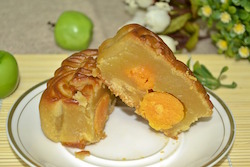 |
|
Scrumptious feasts in Southeast Asia
Poultry and egg dishes are often served during festive occasions in Southeast Asia. The dishes signify as an act of blessing to those who consume them.
Chinese in China, Singapore, and Malaysia celebrate the Lunar New Year, which falls between end of January and mid-February1. During this festive period, the Chinese feast on dishes that represent luck. A whole chicken, roasted or steamed, is consumed to ensure that one’s wishes will be fulfilled and be blessed with good health2. Dumplings, stuffed with chicken and shaped like ingots, are consumed to welcome prosperity3. Fried egg rolls made with pork, napa cabbage, carrot, and mushroom filling resemble gold bars to represent wealth4.
In Vietnam, the locals celebrate their New Year, which is known as Tet Nguyen Dan. It refers to the “Feast of the First Morning on the First Day”. It is similar to the Chinese Lunar New Year, except that it is celebrated for a shorter period of time5. Thit ga or boiled chicken is an important dish to serve to ancestors during Tet Nguyen Dan as it represents purity6. The chicken meets strict preparation regulations such as having bright red crest and small legs. Once cooked, it is decorated with a rose in its beak to represent femininity. The dish is placed on the family’s altar as an offering to the ancestors7.
In Thailand, the Songkran Water Festival is an annual national occasion. The locals will return home to reunite with loved ones, visit temples, and sprinkle water on the shoulders and hands of others as an act of wishing them good luck8. A popular dish prepared during Songkran is laab gai. It consists of minced chicken salad, sticky rice, cucumber, and green beans9.
The Mid-Autumn Festival in Asian countries is a celebration to worship the moon, with the hope to welcome a plentiful harvest in the coming year10. The festival commemorates the moon goddess Chang E, who sacrificed herself to protect her husband’s elixir11. Moon cakes are used as offerings to the moon during this festival. They have a thin tender skin and a sweet filling made of lotus seed paste, sweet bean paste, and egg yolk12. The moon cakes are round in shape to symbolize the reunion of a family and are shared with loved ones to wish them a prosperous life13.
Festive occasions across Southeast Asia bring loved ones closer as they spend quality time together and feast on delicious food that symbolize prosperity, luck, health, and wealth.
References
1 Mirror. (2017). When is Chinese New Year 2017? How to celebrate and what the Year of the Rooster will mean. [online] Available at: http://www.mirror.co.uk/news/world-news/when-chinese-new-year-celebrate-9489513
2 Spoon University. (2016). 9 Chinese New Years Dishes and What They Represent. [online] Available at: http://spoonuniversity.com/how-to/9-chinese-new-years-dishes-represent
3 EatzCatering. (2016). Symbolic Chinese New Year Dishes in Singapore. [online] Available at: http://eatzcatering.com/blog/symbolic-chinese-new-year-dishes-in-singapore/
4 A Blog by Melissa’s Food Service. (2016). Lucky Chinese Spring Rolls. [online] Available at: https://melissasfoodies.com/2016/01/25/lucky-chinese-spring-rolls/
5 2rist App. (2016). Vietnamese New Year – Tet. [online] Available at: https://www.2ristapp.com/zh-hans/blog_post/vietnamese-new-year-tet/
6 Vietnam Online. (2016). Boiled Chicken - A Simple yet Unique Taste of Vietnamese food. [online] Available at: https://www.vietnamonline.com/tet/boiled-chicken---a-simple-yet-unique-taste-of-vietnamese-food.html
7 Vietnam Online. (2016). Boiled Chicken - A Simple yet Unique Taste of Vietnamese food. [online] Available at: https://www.vietnamonline.com/tet/boiled-chicken---a-simple-yet-unique-taste-of-vietnamese-food.html
8 Lucky Rice. (2016). THAILAND’S SONGKRAN FESTIVAL. [online] Available at: http://luckyrice.com/songkran-festival/
9 Lucky Rice. (2016). THAILAND’S SONGKRAN FESTIVAL. [online] Available at: http://luckyrice.com/songkran-festival/
10 China Highlights. (2016). History and Development of the Mid-Autumn Festival. [online] Available at: http://www.chinahighlights.com/festivals/mid-autumn-festival-history-origin.htm
11 Travel China Guide. (2016). Mid-Autumn Festival. [online] Available at: https://www.travelchinaguide.com/essential/holidays/mid-autumn.htm
12 China Highlights. (2016). Mid-Autumn Festival Food — 7 Popular Dishes. [online] Available at: http://www.chinahighlights.com/festivals/mid-autumn-festival-food.htm
13 Travel China Guide. (2016). Mid-Autumn Festival. [online] Available at: https://www.travelchinaguide.com/essential/holidays/mid-autumn.htm |
|
Moon cakes served during the Mid-Autumn Festival |
|
Disclaimer: All opinions and views expressed in the articles published in the newsletter are those of the individual journalists and do not necessarily reflect those of the publisher, the newsletter's sponsors or USA Poultry & Egg Export Council.
You have received this email because you have registered to get newsletters from USAPEEC ASEAN.
If you prefer not to receive these updates, please
click here
to unsubscribe.
Do not reply to this email. For enquiries, go to www.usapeecasean.com
® USA POULTRY & EGG EXPORT COUNCIL
541 Orchard Road, #15-04, Liat Towers, Singapore 238881 Tel: (65) 67371726 Fax: (65) 67371727
*|REWARDS|* |
|
|
|